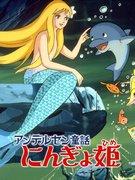Review of "The Little Mermaid: Marina's Adventure": A moving undersea fantasy

Mermaid Princess Marina's Adventure - A touching story born from a fairy taleThe TV anime series "Marina the Little Mermaid," which aired in 1991, is based on Hans Christian Andersen's classic fairy tale "The Little Mermaid." This anime, which depicts the adventures and love of the main character Marina, was loved by many viewers. In this article, we will take a closer look at the appeal of this work, its production background, characters, story, and more, and delve deeper into its appeal. ■Overview of the work"The Little Mermaid: Marina's Adventure" was broadcast on Fuji TV from February 2nd, 1991 to July 27th, 1991, every Saturday from 5:00 am to 5:30 am. The series is made up of 26 episodes, each 30 minutes long. Based on Hans Christian Andersen's "The Little Mermaid," it was directed by Miyano Takehiro, animated by Telescreen, with production cooperation from FCI (Fujisankei Communication International) and Mitsui & Co., and produced by Wako Productions and Fuji Television Network. ■ StoryMarina lives in the sea world as a mermaid princess. One day, she rescues Prince Justin from drowning during a storm and falls in love with him. Dreaming of becoming human, Marina makes a contract with the witch Hedwig to gain human legs, with some restrictions. She then goes on various adventures with Prince Justin. The story centers around the romance between Marina and Justin, and depicts friendship, courage, and facing difficulties. ■Explanation"Marina the Little Mermaid" is based on Hans Christian Andersen's fairy tale, but incorporates its own unique setting and storyline. In particular, the setting in which Marina is given human legs, with restrictions, creates a different development from the original. In addition, the story's depiction of friendship, courage, and the spirit of self-sacrifice through her adventures with Prince Justin moved viewers. The work can be enjoyed by both children and adults, and has gained many fans. ■CastJun Takanosaki played Marina, Takehito Koyasu played Prince Justin, Ryuzo Ishino played Chansey, Tomoe Kitagawa played Headwig, Tessho Genda played Dudley, and Shingo Hiromori played Luther. The voice actors of each character brought out the best in their characters, adding depth to the story. Jun Takanosaki, who played Marina, captured the hearts of viewers with her purity and strength. ■ Main staffThe producers were Shimizu Kenji (Fuji Television), Sekizaki Koichi (Fuji Eight), Takiyama Masao (Fuji Eight), and Takahashi Sumio (Wako Pro). The director was Miyano Takehiro, the character designer was Osako Yoshishige, the music was by Shuki Levi, and the sound director was Chiba Shigeru. The animation was done by Telescreen, with production cooperation from FCI (Fujisankei Communication International) and Mitsui & Co., and the production and copyright were handled by Wako Pro and Fuji Television. This staff worked together to create a wonderful work. ■ Main CharactersMarina is the story's main character, a mermaid princess. She falls in love with Prince Justin after saving him, and dreams of becoming human. Prince Justin is the prince of the country of Gandor, and forms a deep bond with Marina after she saves him. Chansey is Prince Justin's loyal servant and supports him. Headwig is a witch with an eel-like appearance who makes a contract with Marina. Dudley is Headwig's subordinate shark who follows her orders. Luther is the prince of a country that is hostile to Gandor, and interferes with Marina and Justin's relationship. These characters add excitement to the story. ■SubtitleThe subtitles for each episode are as follows:
■ Theme songs and musicThe opening theme "Yume Miru MERMAID" was written by AZUSA, composed by Hiroaki Sei, arranged by Michiaki Kato, and sung by Yumi Hiroki. The ending theme "Pearl na Kimochi" was written by AZUSA, composed by Hiroaki Sei, and arranged by Michiaki Kato. These songs enhanced the atmosphere of the story and left a lasting impression on viewers. ■Production Background"The Little Mermaid" attracted attention in the Japanese animation industry in the early 1990s as a work based on a fairy tale. Hans Christian Andersen's "The Little Mermaid" is a world-famous story, and recreating its charm in animation was a major challenge. The production team provided viewers with a fresh and moving experience by creating their own story and characters while retaining the essence of the original. They also paid particular attention to the selection of music and voice actors, which successfully raised the quality of the work. ■Character AnalysisMarina is a mermaid princess with a pure and kind heart. Her actions symbolize the spirit of self-sacrifice and courage, and move the audience. Prince Justin is a brave and righteous character, and the story depicts the process of his deepening bond with Marina. Chauncey supports Justin as a loyal servant, demonstrating the importance of friendship. Headwig, as a witch, makes a contract with Marina, adding tension to the story. Dudley, as Headwig's subordinate, follows her orders and influences the development of the story. Luther, as the prince of a rival nation, interferes with Marina and Justin's relationship, adding drama to the story. These characters enriched the story and deeply moved the audience. ■Story development"Marina's Adventure" centers on the romance between Marina and Justin and depicts their various adventures and hardships. In particular, the story moved viewers by depicting friendship, courage, and the spirit of self-sacrifice through the contract Marina makes to obtain human legs and her adventures with Justin. As the subtitles of each episode indicate, the story unfolds in a variety of ways, never boring viewers. In the final episode, the bond between Marina and Justin deepens, leading to a touching conclusion. This story development deeply moved viewers and gained many fans. ■Music and voice actorsShuki Levy composed the music for "Mermaid Princess: Adventures of Marina." His music enhanced the atmosphere of the story and captured the hearts of viewers. In particular, the opening theme "Yume Miru MERMAID" and the ending theme "Pearl na Kimochi" became memorable songs for viewers. The selection of voice actors was also important, with Jun Takanomaki as Marina, Takehito Koyasu as Prince Justin, Ryuzo Ishino as Chansey, Tomoe Kitagawa as Headwig, Tesshō Genda as Dudley, and Shingo Hiromori as Luther bringing out the best in each character's individuality and adding depth to the story. These music and voice actors enhanced the appeal of the work. ■ Viewer reactions"Marina the Mermaid" was loved by many viewers when it was first broadcast. In particular, the friendship, courage, and spirit of self-sacrifice depicted through the romance and adventures of Marina and Justin left a deep impression on viewers. As the subtitles of each episode suggest, the story unfolded in a variety of ways, never boring viewers. In the final episode, the bond between Marina and Justin deepened, leading to a touching conclusion. These elements deeply moved viewers and earned the series many fans. ■ Evaluation of the work"The Little Mermaid" was highly praised as a work based on a fairy tale. In particular, the friendship, courage, and spirit of self-sacrifice depicted through the romance and adventures of Marina and Justin deeply moved viewers. Furthermore, as the subtitles of each episode suggest, the story unfolded in a variety of ways, never boring viewers. In the final episode, the bond between Marina and Justin deepened, leading to a moving conclusion. These elements raised the film's acclaim. ■Reasons for recommendation"Marina the Little Mermaid" was loved by many viewers as a work based on a fairy tale. In particular, the friendship, courage, and spirit of self-sacrifice depicted through the romance and adventures of Marina and Justin deeply moved viewers. As the subtitles of each episode suggest, the story unfolded in a variety of ways, never boring viewers. In the final episode, the bond between Marina and Justin deepened, leading to a touching conclusion. These elements increased the appeal of the work and won it many fans. Be sure to experience this moving story for yourself. |
<<: Shakotan★Boogie: A look into the appeal of unique characters and stories
Recommend
"Delicious Party♡PreCure" movie review: What is the appeal of the Dreamy♡Children's Lunch?
Appeal and evaluation of the movie "Deliciou...
Japanese weekly revealed that a national-level animation movie singer was sexually assaulted, and netizens speculated that it was Lisa
Today, January 28, a Japanese weekly cover story ...
Angels and Demons on the Phone: The Importance of Etiquette
Telephone angels, telephone devils Telephone etiq...
The appeal and reviews of "Pretty Guardian Sailor Moon S": A moving story and deepening characters
Sailor Moon S - Sailor Moon Super Released on Dec...
President Tsuburaya's sharp comments on the humanity of "Shin Ultraman" will be released on May 13
The remake of a classic tokusatsu film, with Hide...
Famous director Mamoru Oshii's new animated film "VLADLOVE" is scheduled to be released in 2020
The animated film, which was originally written a...
"Better Days" enters the top 10 domestic film box office!
On the 8th day of its release, Better Days grosse...
Paw Patrol Movie 2: Super Power Adventures is set to be released on September 29. Watch Paw Patrol during the Mid-Autumn Festival and National Day
Co-produced by Paramount Pictures, Nickelodeon, a...
The new trailer of the live-action movie "Kingdom 2" is scheduled to be released on July 15
The second live-action film of the classic anime ...
"The Little Mermaid" UK premiere actress wears deep V skirt to show sexy figure
Recently, Disney's live-action film "The...
Mission: Impossible 7: Tom Cruise looks a bit old in new set photos
Today (October 12), foreign media released new on...
Star-Lord's voice-over caused controversy, but the trailer of "Super Mario: The Movie" still received overwhelming praise
Despite the ongoing debate surrounding Star-Lord ...
Detailed review and evaluation of Dragon Ball Z Gaiden: Plan to Exterminate the Saiyans
"Dragon Ball Z Gaiden: Plan to Exterminate t...
She-Hulk releases new trailer, Tim Roth returns to Abomination
Marvel released the latest trailer for She-Hulk a...
The first trailer for the horror film "Scary Stories to Tell in the Dark" produced by the director of "The Shape of Water"
The horror film "Scary Stories to Tell in th...









